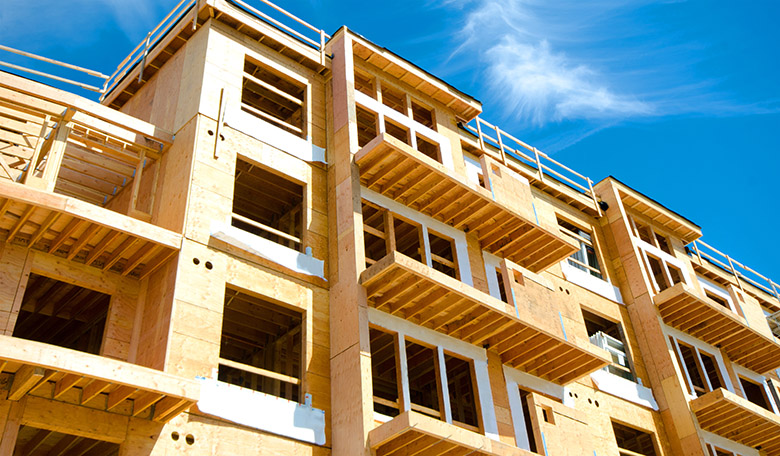Building the Future Part 3: Sustainable Building With Classic Wood
Advancements in the construction industry have always revolved around the careful balance of innovation, sustainability, and safety. From skyscrapers of steel to eco-friendly concrete solutions, the materials used to build our environments are as important as the blueprints themselves. Yet, with the rising demand for sustainable building solutions, one age-old material is making a modern comeback — wood.
As our Building the Future series continues, let’s examine how wood construction offers sustainability and unique structural and environmental benefits. However, to fully capitalize on its potential, rigorous construction materials testing is indispensable. At Terradyne, we are committed to ensuring that every material used in construction, including wood, meets the highest safety and quality standards.
This post explores the resurgence of wood as a construction material, its challenges and benefits, and why proper testing is fundamental to building a safe and resilient future.
The Rise of Wood in Sustainable Construction
Wood has been a staple in construction for centuries. Its natural beauty, versatility, and ease of use make it a favorite for residential buildings, interiors, and even large-scale commercial projects. With advancements in engineered wood products like plywood and glulam, wood continues to find innovative applications in modern construction.
With increasing attention to climate change and environmental conservation, construction practices are evolving to incorporate materials with lower environmental impacts. Wood, long known for its versatility and natural aesthetic, has emerged as a top choice in sustainable building projects.
However, wood is susceptible to environmental conditions such as moisture and pests. Proper treatment and selection of wood types are essential for ensuring durability and performance.

Why Wood is Trending Again
Carbon Sequestration: Unlike steel and concrete, which have high carbon footprints, wood helps remove carbon dioxide from the atmosphere. Trees absorb CO2 during their lifetime, storing it within their fibers—even after being processed into construction-grade materials. This makes wood one of the few carbon-negative building materials available.
Renewable and Recyclable: Wood is renewable when harvested responsibly using regulated forestry practices. Additionally, at the end of its lifecycle, wooden materials can often be recycled or repurposed, reducing waste.
Aesthetic Appeal: The natural beauty of exposed wood beams or paneling is unmatched, offering a warm, inviting look that many modern designs crave.
Innovations in Engineered Wood: Modern engineered wood products, such as cross-laminated timber (CLT) and glue-laminated timber (glulam), have advanced wood's structural capabilities, allowing its use in high-rise and large-scale projects.
Wood Properties
Wood's properties vary widely depending on the species and treatment. Key characteristics include density, moisture content, and grain pattern, which influence wood's strength, durability, and aesthetic appeal.
Selecting the right type of wood and ensuring proper treatment can mitigate issues related to moisture and pests. Testing wood for its physical and mechanical properties helps ensure its suitability for specific applications.
The Role of Materials Testing in Wood-Based Construction
In the same way that soil testing impacts infrastructure development, wood and all building materials must undergo rigorous construction materials testing regardless of their environmental and aesthetic appeal to ensure they are safe, efficient, and durable for all types of building projects.

Why Testing Wood Is Critical
Structural Validation: Not all wood is created equal. Factors such as species, grain structure, and moisture content significantly determine its strength and performance. Testing helps identify the right wood for specific construction needs.
Moisture Content Analysis: Moisture-warped wood can compromise the safety and structural integrity of a building. Testing to determine appropriate moisture levels ensures wood remains stable over time.
Fire Resistance Assessment: Wood can be treated or laminated with fire-retardant materials, but it should undergo fire-resistance testing to ensure it meets safety codes and reduces risk.
Durability Testing: Before use, wood should be examined for its resistance to decay, insect damage, and external environmental factors. Hardness tests assess a wood's resistance to wear and denting. This is especially important for applications like flooring or furniture, where surface durability is crucial.
Strength Testing: Wood is subjected to various stress tests to determine its load-bearing capacity and identify how it reacts under pressure. This ensures that the wood used in construction can safely support structural loads.
Thermal Conductivity Testing: Wood's natural insulation properties are evaluated to determine its suitability for energy-efficient construction, helping to regulate indoor temperatures in different climates.
How Terradyne Ensures Wood Quality
At Terradyne, our team brings decades of expertise and cutting-edge technology to construction materials testing for wood and any construction material. From evaluating tensile strength in engineered timber to performing fireproofing materials inspections, our comprehensive assessments ensure your projects meet regulatory standards and stand the test of time.
Additionally, we collaborate closely with stakeholders, builders, developers, and architects to provide tailored testing solutions that align with the unique requirements of each project.
Testing for a Safer, More Sustainable Future
Building the future is more than innovation; it ensures that every material contributes to safer, longer-lasting structures. Whether you’re working with wood, concrete, or steel, construction materials testing is non-negotiable for resilient, sustainable developments.
Wood offers unique opportunities for greener construction while presenting challenges that demand precision and expertise. At Terradyne, we’re proud to support builders and developers with the testing services they need to bring sustainable projects to life without compromise.
Ensure your next project is built on solid ground—partner with Terradyne for your construction materials testing, soil reporting, and more!